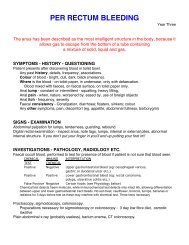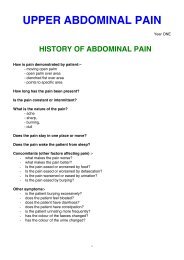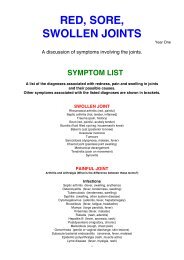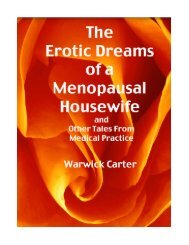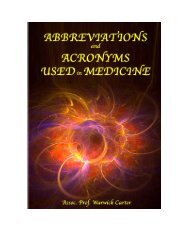Menopause A to Z.pdf - Medwords.com.au
Menopause A to Z.pdf - Medwords.com.au
Menopause A to Z.pdf - Medwords.com.au
Create successful ePaper yourself
Turn your PDF publications into a flip-book with our unique Google optimized e-Paper software.
MENOPAUSE A <strong>to</strong> Z<br />
BODY ODOUR<br />
Bromhidrosis is the medical term for an unpleasant body odour.<br />
The body produces two very different types of sweat. About 2.5 million eccrine glands produce sweat all over the<br />
body in order <strong>to</strong> assist in regulating excessive body heat by evaporation, but apocrine glands produce a very different,<br />
oilier form of sweat in the armpits, groin, and around the nipples, that contains the sexually attractive pheromones.<br />
Increased sweating obviously occurs with exercise and in hot weather, but it may also increase with stress, and<br />
people who are suffering from long term or persistent stress may develop a noticeable body odour that disappears<br />
when the stress goes away. The hormonal changes associated with puberty, pregnancy and menop<strong>au</strong>se may also<br />
c<strong>au</strong>se a temporary increase in sweating.<br />
Neither form of sweat has any significant smell, but the apocrine sweat is a good breeding ground for bacteria, and<br />
it is the break down of the oily apocrine sweat by bacteria that produces most body odour.<br />
Body odour can obviously be controlled by regular bathing, particularly after vigorous exercise, but sometimes this<br />
is insufficient and antiseptic soaps that reduce the number of bacteria on the skin is the next step.<br />
Commercial antiperspirants and deodorants containing aluminium or zinc <strong>com</strong>pounds that reduce sweating are the<br />
obvious next step. An antiperspirant blocks the pores in the skin and prevents the sweat leaving the skin, while<br />
deodorants allow sweat <strong>to</strong> escape but destroy bacteria or mask smells. Unfortunately, some people find that even<br />
these are inadequate.<br />
Cot<strong>to</strong>n clothing breathes better than synthetics, and is less likely <strong>to</strong> c<strong>au</strong>se the accumulation of sweat and therefore<br />
odours. Cot<strong>to</strong>n underwear should always be worn. L<strong>au</strong>ndering clothes regularly, and using an antibacterial additive <strong>to</strong><br />
the wash may also be helpful.<br />
Hydrogen peroxide can be used <strong>to</strong> wash the skin in the armpit and groin, but ensure that there are no cuts (it will<br />
sting) and avoid the vagina.<br />
Zinc supplements in the diet may help some forms of body odour as it increases the level of zinc in sweat and<br />
discourages bacterial growth.<br />
In a small number of cases it is necessary for doc<strong>to</strong>rs <strong>to</strong> prescribe special antibiotics, either as a solution or tablet,<br />
that reduce the load of bacteria on the skin. These cannot be used long term, only intermittently.<br />
Some people have a slightly beery smell, despite not consuming large quantities of this in<strong>to</strong>xicant. In this case a<br />
fungal (yeast) infection may be responsible for the odour.<br />
What is an unpleasant body odour <strong>to</strong> one person may actually be quite attractive <strong>to</strong> others in some circumstances.<br />
This is particularly the case in body odours due <strong>to</strong> spicy foods as some of the spice may be excreted in the sweat.<br />
Diabetics whose sugar levels are poorly controlled may have an ace<strong>to</strong>ne-like (nail polish remover) smell about<br />
them. This is a serious sign, and they should be <strong>to</strong>ld of the problem and urged <strong>to</strong> seek immediate medical advice.<br />
Rarely, an ammonia smell may be a sign of severe liver disease.<br />
People with body odour problems may not be aware that they have a problem, so a quiet word <strong>to</strong> them from a<br />
friend, or even a carefully worded anonymous note, may make them aware, so that they can seek a solution.<br />
These people may also have problems in their personal, social, school and work life which may result in loss of<br />
friends, school bullying, failing <strong>to</strong> be promoted and missing social events.<br />
BREAST CANCER<br />
Mammary carcinoma is the technical name for this all <strong>to</strong>o <strong>com</strong>mon cancer that affects one in every eleven women<br />
at some time in their life.<br />
The absolute c<strong>au</strong>se is unknown but it is more <strong>com</strong>mon in women who have a close relative (mother, sister,<br />
d<strong>au</strong>ghter) with the disease, in women who have not had a pregnancy, have not breast fed, have had a first pregnancy<br />
after 35 years, in white women, those who have had uterine cancer, and in higher socio-economic groups. On the other<br />
hand, women who start their periods late and those who have an early menop<strong>au</strong>se have a lower incidence of breast<br />
cancer. About 2% of all breast cancers occur in men as they have a tiny amount of breast tissue present just under the<br />
nipple.<br />
Extraordinarily, left-handed women have double the risk of developing breast cancer <strong>com</strong>pared <strong>to</strong> those who are<br />
right handed.<br />
The symp<strong>to</strong>ms are a hard, fixed, tender lump in the breast. The nipple skin itself can be<strong>com</strong>e cancerous (Paget’s<br />
disease of the nipple) c<strong>au</strong>sing a thick, firm, rubbery feeling <strong>to</strong> the nipple. There are many other c<strong>au</strong>ses of lumps in the<br />
breast and less than one in ten breast lumps examined by a doc<strong>to</strong>r is cancerous.<br />
One method of detecting breast cancer is monthly self-examination. The diagnosis is confirmed by an x-ray<br />
mammogram, ultrasound scan of the breast and needle biopsy.<br />
The most <strong>com</strong>mon form of treatment is a lumpec<strong>to</strong>my in which only the cancer itself is removed, but if it is <strong>to</strong>o large<br />
for this procedure a simple mastec<strong>to</strong>my, in which only the breast is removed, may be performed, leaving a cosmetically<br />
acceptable scar and scope for later plastic reconstruction of the breast. Often the lymph nodes under the arm will be<br />
removed at the same time. A course of radiotherapy and/or chemotherapy (drugs) may also be given. Tamoxifen,<br />
13




